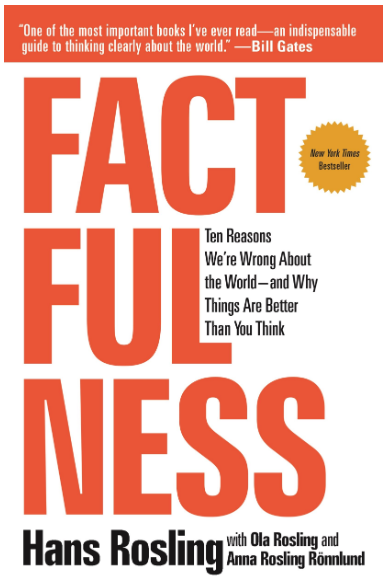 Let’s start with a quiz.
Let’s start with a quiz.
1. In all low-income countries across the world today, how many girls finish primary school?
A. 20 percent B. 40 percent C. 60 percent
2. In the last 20 years, the proportion of the world population living in extreme poverty has
A. almost doubled B. almost halved C. remained about the same
3. The life expectancy in the world today is
A. 60 years B. 70 years C. 50 years
4. How many of the world’s one-year-old children have been vaccinated against some disease?
A. 20 percent B. 50 percent C. 80 percent
5. What percentage of the world’s population have some access to electricity?
A. 80 percent B. 55 percent C. 20 percent
6. Today there are 2 billion children in the world. How many will there be in 2100?
A. 2 billion B. 4 billion C. 3 billion
These quiz items come from a book called Factfulness by Hans Rosling. Bill Gates calls Factfulness, “one of the most important books I’ve ever read.”
Rosling was an extraordinary man. He was a doctor who traveled the world treating people in developing countries and educating people in developed countries about the developing world. He was particularly passionate about dispelling negative myths about the lack of progress in developing countries and replacing those myths with facts.
Evolution has hardwired humans to be highly attentive to negative information. Survival has required heightened awareness to threats. Media outlets intuitively understand this, which is why news on TV, radio, and newspapers historically has been overwhelmingly negative. Negativity sells, which is why if it bleeds, it leads.
My colleague, Ron Matus, has highlighted the impact of negativity bias on how Florida’s media covers public education. Ron has repeatedly cited examples (here, here, here, here, and here) of Florida’s media not reporting positive information about how well our public education system is performing.
One of the downsides of our attraction to negative information is that it often causes us to base our decisions on misinformation. For example, we may be less supportive of public education funding if we are convinced the system is performing poorly, or we may be more supportive of greater restrictions on immigration from a developing country if we exaggerate the amount of that country’s poverty, violence and illiteracy.
Throughout his book, Rosling identifies cognitive habits that contribute to our embracing of negative myths. These habits of mind are manifestations of three well-documented cognitive biases: negativity bias, confirmation bias and availability bias.
Negativity bias refers to our tendency to be more attuned to and affected by negative information and events. Confirmation bias is the tendency to seek out evidence that supports our existing beliefs and ignore evidence that does not. And availability bias is our tendency to assume that information that is readily available to us is more reflective of general conditions than actually is the case. Availability bias is why people think traveling by plane is more dangerous than traveling by car immediately after a high-profile plane crash.
These three biases work in tandem to make negative thinking predominate in humans. We are more attracted to negative beliefs (negativity bias). We seek out information to confirm these negative beliefs (confirmation bias), and then we exaggerate the prevalence of these negative beliefs (availability bias).
This is the pattern Matus has documented in his reporting on how Florida’s media cover our public education system. Florida’s education reporters are attracted to information they think confirms their negative biases. They then report this confirming negative information while excluding contrary facts. This results in many people having an inaccurate, and overly negative, opinion of Florida’s public education system.
Rosling hopes that by increasing global awareness about how believing and promoting inaccurate negative information distorts our perceptions and undermines our decision making, people will be less susceptible to the detrimental effects of negative myths. He worries that too much negative thinking encourages a sense of hopelessness that undermines motivation.
According to every objective measure, this is a golden age for Florida’s public education system. We still have huge unmet challenges, most notably in addressing a large achievement gap that is correlated with racial, ethnic and economic class differences. But we have much progress to celebrate and to inspire us to keep going.
If we can effectively manage our negativity bias, our greatest successes still lie ahead.
Here are the quiz answers: 1 C; 2 B; 3 B; 4 C; 5 A; 6 A. How much influenced did negativity bias have on your answer?


